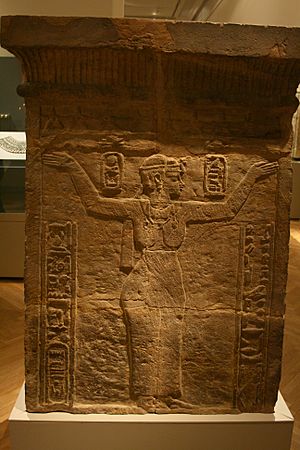Amanitore facts for kids
Quick facts for kids Amanitore |
|
|---|---|
| Queen of Kush | |

Amanitore at Wad ban Naqa
|
|
| Reign | 1 BCE – 20 CE |
| Predecessor | Teriteqas (50 BCE–1 BCE) |
| Successor | Kandake Amanitaraqide |
| Born | Unknown |
| Died | 20 CE |
| Burial | Pyramid at Meroë |
| Egyptian | Merkare |
| Dynasty | Meroitic |
Amanitore was a powerful queen of the ancient Kingdom of Kush. This kingdom was also known as Nubia. She was a "Kandake," which means a queen who ruled on her own. Her reign lasted from about 1 BCE to 20 CE. In ancient Egyptian writing, her royal name was Merkare. Many Kandakes were known as strong warrior-queens who led their armies into battle.
Contents
Amanitore's Rule
Amanitore often ruled alongside Natakamani. It's not fully clear if she was his wife or his mother. However, a Kandake held a very important position in Kush. Mothers could rule and even choose their sons as rulers. They could also remove their sons from power if needed.
Her Royal Home
Amanitore's royal palace was located at Gebel Barkal. This place is in modern-day Sudan and is now a UNESCO World Heritage site. Her kingdom stretched between the Nile and the Atbara rivers.
Time Period and Successor
Amanitore was part of the Meroitic period of history. Her rule began in 1 BCE. Her successor, Amanitaraqide, took over by 50 CE.
Building Projects and Prosperity
Amanitore was one of the last great builders in Kush. She helped restore a large temple for the god Amun in Meroë. She also rebuilt the Amun temple in Napata after the Romans damaged it. During her reign, they also built reservoirs in Meroë to store water. Amanitore and Natakamani also constructed Amun temples in Naqa and Amara.
The many buildings completed during this time show that it was a very rich period for Meroë. More than two hundred Nubian pyramids were built. Sadly, most of these pyramids were robbed long ago.
The Kingdom of Kush
Kush was located just south of ancient Egypt. It shared some language with Egypt in its written texts. Other parts of Kushite culture were different, but some also influenced ancient Egyptian culture, especially religious ideas. Kush was a very wealthy country. It had large amounts of gold. It also exported valuable items like jewelry, exotic animals, and textiles to other lands.
Images for kids
See also
 In Spanish: Amanitore para niños
In Spanish: Amanitore para niños




